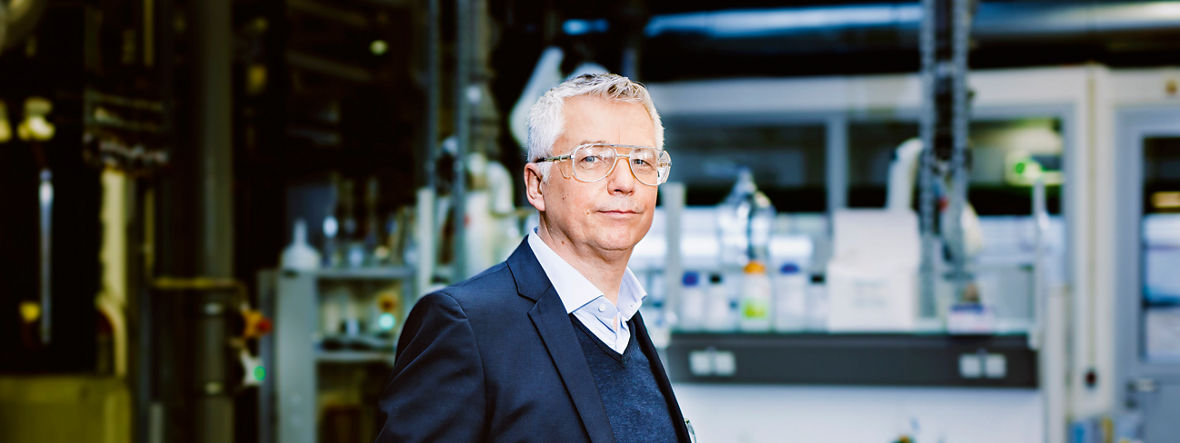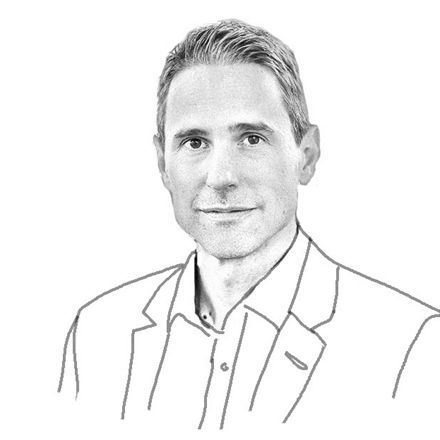Mr. Leitner, research on CO2 utilization has been going on for a long time. In the past, many projects ran aground because they were only able to produce small amounts of materials. Is that also true of the Rheticus project?
Of course we’re looking for solutions on an industrial scale. That’s the purpose of the Power-to-X projects. One key criterion of success has to be whether or not we can ultimately, as the goal of our vision, create carbon-neutral production processes for fuels and for complex chemical products. In this endeavor, smaller volumes are also important and valuable, because they make the business case—in other words, the calculation of a business model—easier.
Could the production of chemicals be completely decentralized in the future? In the same way as the generation of renewable energy?
Decentralization is a really major topic, and it’s being extensively discussed in our group. Petrochemistry largely operates via large chemical facilities and takes advantage of economies of scale— but that could change. The production of chemicals could shift to places where you wouldn’t expect it, such as biogas and wind power facilities. This is not a trivial issue. Is it easier to bring electric power to the consumer or to bring the consumer to the energy production facility? Logistics and social acceptance both play a role here. In order to answer this question, concepts such as Rheticus, which make modular facilities possible, are valuable.
How strongly do political decisions influence the success of such projects? After all, energy policy in particular is constantly being modified and repaired.
The fundamental vision of an “interlinking of sectors”—in other words, the integrated use of carbon-free power generation and alternative carbon sources—is independent of political frameworks, and it’s a central component of sustainable chemical production. However, business cases change in tandem with the prices of raw materials and energy, and energy prices are of course also influenced by political decisions. People basically should not reduce the Power-to-X projects to a means of cushioning the effects of spikes in the power supply. Value should be created no matter what is done in this regard. In the course of the energy transition as a whole, we may have focused too strongly on the expansion of renewable energy generation alone. In particular, Power-to-X projects can help to restore a better balance between the environment-friendly generation of energy and its economically viable consumption.
Kopernikus
In the Kopernikus projects for the energy transition, scientists, industry, and users are working together to develop new energy systems and energy concepts to the point of large-scale industrial application. Kopernikus is the biggest research initiative of the German Federal Ministry of Education and Research concerning the energy transition. The ministry is providing € 400 million between 2015 and 2025 for the following four topic areas:
New power grid structures (ENSURE)
Goal: reducing the costs of restructuring the power grid by combining centrally and decentrally generated electricity
Power-to-X (storage of excess electricity)
Goal: storing more than 90 percent of the renewable energy that is not used immediately, in the form of chemical base materials, gas or fuel
Industrial processes (SynErgie)
Goal: adapting energy-intensive production processes to a fluctuating energy supply
Systems integration (ENavi)
Goal: forging ahead with the energy transition in a sustainable manner with the greatest possible degree of social acceptance
The Power-to-X consortium alone unites 46 partners—research institutes, industrial companies, and social institutions. Why do you need such a complex organization?
We want to form a national platform for this topic and to bring together the areas of expertise that are scattered throughout Germany. We have a broad spectrum of stakeholders that represent specific interests and, most importantly, can also bring in existing infrastructures and research activities. These stakeholders represent the entire spectrum of the value chain, ranging from renewable energy generation to chemical products and engines— in the latter case, if they are fuel producers.

»Power-to-X projects can help to restore a better balance between the environment-friendly generation of energy and its economically viable consumption«
WALTER LEITNER RWTH Aachen
What exactly is new about Power-to-X?
Mainly the interlinking of sectors that I mentioned before—in other words, the fact that we are bringing together very different industrial sectors against the background of the technologies we want to develop. These sectors range from energy generation to the chemical sector, the processing industry in the area of emerging chemical products, and the automotive sector. In addition, there’s a new dimension in play here: the use of renewable forms of energy as an input for the conversion of materials. We’re doing more than “only” producing methane in order to store energy. Or, to put it in other words, we’re harvesting renewable forms of energy! And we’re also doing this in complex chemical molecules for various value chains, not only in simple compounds for storing energy.
How is Power-to-X organized?
The first three clusters are examining how chemical base materials—for example, carbon monoxide and hydrogen—are produced from electrical energy. These “power molecules” are then the focus of the next three clusters, which are examining how to use them to create chemical products with a higher added value. From a chemist’s perspective, one could say that we’re first doing the electrolysis part, followed by the catalysis part.
That’s the chemistry aspect. What about social acceptance of the projects? Social institutions are of course involved in the Kopernikus initiative. How have the discussions developed so far?
They’ve been very intense. And harmony hasn’t always reigned. …But the debates are very constructive. For all of the projects, there’s a trio of sustainability issues: economy, ecology, AND social acceptance. For example, it’s helpful to jointly consider at an early stage what community participation models might look like in a decentralized chemical production network. Municipalities can also participate, just as they would in the case of a wind turbine. However, this is still only a vision of the future. However, we are continuing this debate in parallel to our technical research. The goal is participation. The term “acceptance” doesn’t really go far enough.
But basically there’s nothing to criticize about the concept of Power-to-X, is there?
Well, there are some open questions. For example, there’s the question of whether we utilize “excess electricity” or build specific facilities such as wind turbines to supply the chemical production plants with energy. Another question is how high the product risk is for the decentralized production of chemicals. In a chemical park everything is safeguarded, but at a site somewhere out in the country it isn’t. We’re dealing here with the discrepancy between local environmental protection, on the one hand, and global climate protection, on the other.
You’ve already spent many years doing research in the area of sustainable chemical production. Now this gigantic research offensive is falling into your lap, so to speak. Has Kopernikus been a godsend for you personally?
Of course I’m absolutely thrilled by the dynamism that is now streaming into this field! But the project didn’t really come to us out of the blue. In order to get it, we had to do some work in the coordination group, together with Prof. Kurt Wagemann from Dechema and Prof. Rüdiger Eichel from the Jülich Research Center. …The chemical conversion of fossil raw materials has made wonderful things possible for us—lengthening life expectancy, feeding ever larger numbers of people, raising standards of living— but it has also had an impact on the environment, especially in terms of CO2 emissions. We are now being given the opportunity to shrink our carbon footprint, while at the same time making better chemical products. That’s a wonderful thing.
Kopernikus will run until 2027. What’s your desired result for the projects?
I want us to take at least three technologies to the point where they can take, or have already taken, the step into real industrial production. Rheticus is already developing in the right direction by leaps and bounds.


